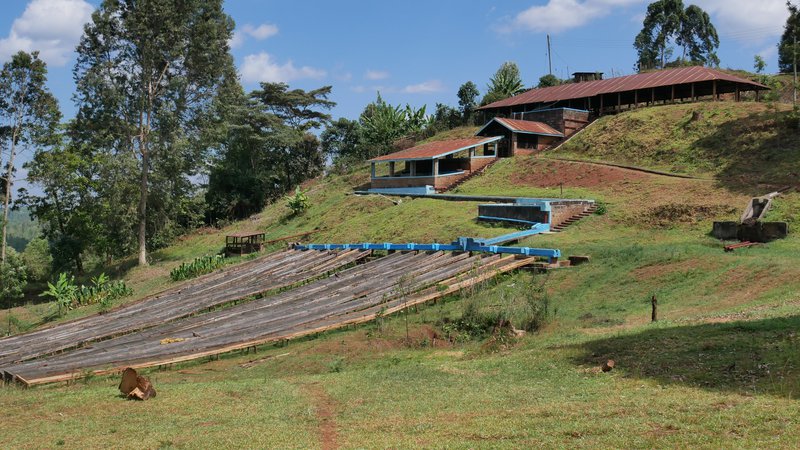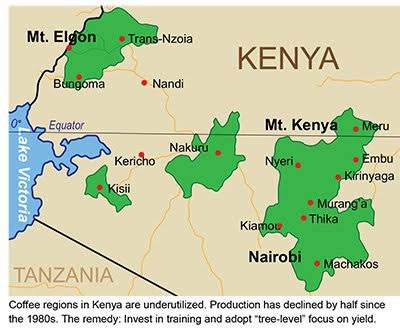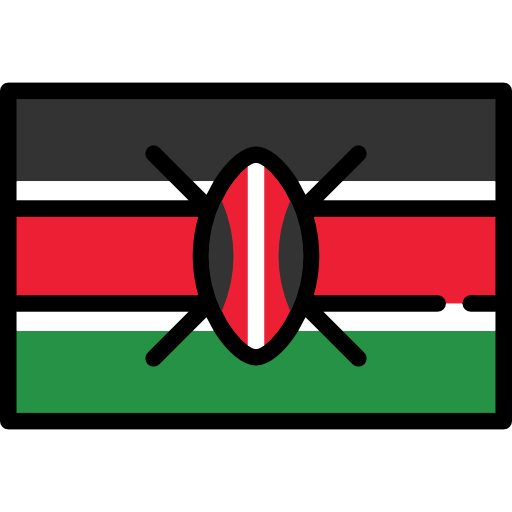Coffee in Kenya

VARIETALS
Traditional Varietals
- SL 28
- SL 34
Both SL varietals are sensible to Coffee Berry Disease and Coffee Leaf Rust
- K7
New Varietals resistant to CBD and CLR
- Ruiru 11 (released in 1985)
- Batian (released in 2010)
COFFEE REGIONS
- Central Province — Nyeri, Murang’a, Kiambu, Thika, Kirinyaga.
- Eastern Province — High areas of Meru Central, Embu, Machakos, Tharaka and Makueni.
- Coast Province — Taita Taveta (Wundanyi area).
- Western Province — Bungoma,Vihiga, Kakamega.
- Nyanza Province — Kisii, Nyamira, Nyabondo Plateau in Nyando District and Oyugis in Rachuonyo District.
A BIT OF HISTORY
Coffee was first introduced in Kenya in 1893. Until 1930, it was reserved for the European colons. It's only after that date that African people were conceaded the right to produce coffee, first in the region of Kisii on the rift valley and in Meru County on the slopes of Mount Kenya. Nowadays, coffee is produced all over the country with a big concentration around Nairobi and Mount Kenya.
The level of production has increased during the 60's/70's, time when were introduced through cooperatives and following the initiative of the government, new agricultural practises such as pruning and using fertilizers and pesticides to increase the yields. And in the 80's, a new coffee variety called Ruiru 11, more resistant to coffee berry disease and leaf rust, was distributed to farmers
Since the collapse of quota agreements in the early 1990s that had been put in place by members of the International Coffee Organization since 1963, coffee prices have fallen drastically, with consequent lower earnings for the farmers. This, combined with climate change, expansion of coffee leaf rust and coffee berry disease, lead to a decline by 62% of the coffee production since 1988. In the lower altitudes, coffee has been replaced by dairy and food crops.
PRODUCTION SYSTEM
Most of the producers (70%) are small scale farmers organized into factories and cooperatives to which they deliver their coffee cherry. They do ot take care of the process themselves.
They are usually paid after the conclusion of the purchase and after deduction of the potential uses of inputs they might have during the year to manage their farm. Sometimes cooperatives can also make advance on payments when they have sufficient cash flow.
Cooperatives are the owner of the wet mills and they take care of the whole process (generally fully-washed) from the pulping to the drying. They can also facilitate access to inputs, fertilisers, chemicals and can organised training sessions for the farmer's. Each cooperative has minimum 1 wet factory (wet mill). Some have up to 14.
When the farmers deliver the coffee cherries, they are paid by kg and quality. Poor quality cherries (unripe, overripe mbuni or cherry affected by diseases) are sorted out before processing.
Factories process the cherries following the fully-washed method: beans are put in fermentation tanks and covered with water after pulping, They are left between 24-48h until removing all the mucilage.
Then, coffee beans are washed in leveled canals to allow the grading according to the density. The heaviest stays on the hhigher stages while the lightest goes until the end.
Following this grading, beans are put into drying tables and left to dry until reaching 12% of moisture. During this time, beans will be removed regularly to allow good and homogeneous drying.
Sometimes, after being washed and before the drying phase, some factories put an additional step: they soak the beans into clear water during an additional time to finish polishing the bean and bring clean and bright acidities. This is called the Kenyan process.
Once the beans have reached the level of 12% moisture, they are put to rest into storing warehouses for a couple of months. Then, they will be brought to the dry mill (the miller) to remove the parchment and be graded before being sold.
It's different for coffee estates that have their own processing factories and sometimes, their own dry mill to remove the parchment.
TRADING SYSTEM
The 1933 Coffee Act has introduced the auction system run by the government. 90% of the coffee is currently sold through auctions.
The auction system is considered as an example of transparency as it is based on the quality and the grading of the coffees. It takes place every Tuesday in Nairobi Coffee Exchange. Participation to the auctions is however restricted to licensed marketing agents and dealers.
So farmers's cooperative need to contract the services of at least one marketing agents to be able to selle their coffees.
Marketing agents are authorized to store and trade green coffee on behalf of the farmers and/or cooperatives, to process to payment and sometimes to give advance of payment to the growers.
They have also an important role supporting the farmers and cooperative they represent. They aim at improving both volume and quality. To do so, they might offer financial (payment advance, certifications), material (buying new pulper or drying tables) and even human support through for examples training of the factory staff, the farmers, encouraging domestic consuming etc
Since 2006 and the introduction of the "second window" system, it is theorically possible for farmers to sell their coffee directly to an international buyer and to negotiate a contract signed and registered by the coffee board,.
In practise though, farmers or cooperative couldn't enter the international market so easily as they had neither enough money to buy the license nor the sufficient connections, skills and knowledge of marketing and logistics. So in reality this second window has reinforced the position of the marketing agents, giving them more possibilities to reach international market directly and to get an additionnal commission.
ISSUES AND CHALLENGES
Coffee fanning in Kenya is experiencing a number of problems. Some of these are:
- Aging farmers : coffee farming no longer attract new generations that give up the lands to produce other cash crops.
- Soil exhaustion: Soils have been exhausted since coffee places a high demand on soil nutrients.
- Climate change: Inadequate and unreliable rainfall lowers the quality and quantity of the yield.
- Price fluctuations: Fluctuation of prices in the world markets discourages the farmers.
- Pests and diseases: Pests and diseases like leaf rust, coffee berry disease, root rot destroy the crops reducing the yields.
- Farming depending only on expensive farm inputs: High prices of farm inputs reduce the farmers profit margins.
- Limited land for expansion: The available land is facing competition from other well paying crops offered by the horticultural sector. Coffee farmers therefore may not expand quite easily.
- Delayed payments: Delayed payments to farmers for the crop delivered. This lowers their morale in coffee production.
- Mismanagement: Coffee co-operative societies have been mismanaged leading to embezzlement of funds. This has led to low income for the farmers.
- Logistics: Some of the feeder roads in the growing areas are poorly maintained and impassable during the rainy season.
- Domestic market: try to increase the domestic market from 2% to 15%, encouraging national professionalisation of the sector.
****

Coffee producing areas
****
Harvest Time
Main crop | September to December
Fly crop | March to July

 Colombia
Colombia Ethiopia
Ethiopia Guatemala
Guatemala Indonesia
Indonesia Kenya
Kenya Mexico
Mexico Philippines
Philippines Tanzania
Tanzania Uganda
Uganda